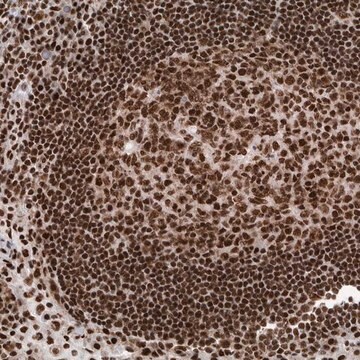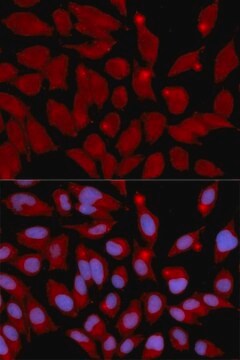SRP0396
DNMT3A/DNMT3L active human
recombinant, expressed in baculovirus infected Sf9 cells, ≥90% (SDS-PAGE)
Iniciar sesiónpara Ver la Fijación de precios por contrato y de la organización
About This Item
Código UNSPSC:
12352200
NACRES:
NA.32
Productos recomendados
origen biológico
human
recombinante
expressed in baculovirus infected Sf9 cells
Ensayo
≥90% (SDS-PAGE)
Formulario
aqueous solution
mol peso
34 kDa (MLL1)
52 kDa (DNMT3L)
envase
pkg of 10 μg
Nº de acceso NCBI
Nº de acceso UniProt
Condiciones de envío
dry ice
temp. de almacenamiento
−70°C
Información sobre el gen
human ... DNMT3A(1788) , DNMT3L(29947)
Descripción general
The DNMT3A (DNA (cytosine-5)-methyltransferase 3A) gene is mapped to human chromosome 2p23. The encoded protein has 2 isoforms, DNMT3A1 and DNMT3A2. DNMT3A1 is widely expressed and DNMT3A2 is mainly present in embryonic stem cells (ovaries and testes).
DNMT3L (DNA (cytosine-5)-methyltransferase 3-like) belongs to the Dnmt3 family. It is unable to methylate DNA. The protein has a cysteine-rich region containing a novel-type zinc finger domain. The gene is mapped to human chromosome 21q22.3.
DNMT3L (DNA (cytosine-5)-methyltransferase 3-like) belongs to the Dnmt3 family. It is unable to methylate DNA. The protein has a cysteine-rich region containing a novel-type zinc finger domain. The gene is mapped to human chromosome 21q22.3.
Aplicación
DNMT3A/DNMT3L active human has been used in in vitro methylation assay and REMSA (RNA electrophoretic mobility shift assay) to study role of ecRNAs (extra coding RNAs) in DNA methylation.
Acciones bioquímicas o fisiológicas
DNMT3A (DNA (cytosine-5)-methyltransferase 3A) is a DNA methyltransferase. It is responsible for the methylation of the cytosine residue in 5′-C-phosphate-G-3′ (CpG) dinucleotides. DNMT3A plays a significant role in immunoregulation (adaptive as well as innate immune responses). It is also the most commonly mutated gene in hematologic malignancies. DNMT3A is a commonly mutated gene in acute myeloid leukemia and is responsible for an unfavorable prognosis.
DNMT3L (DNA (cytosine-5)-methyltransferase 3-like) is mainly responsible for the stimulation of DNA methylation. It is a non-catalytic accessory factor. It helps the DNA methylation machinery to be placed on properly chromatinized DNA regions. It also helps the poorly methylated area, thereby providing uniform methylation patterns. Mutations in the DNMT3L gene might be associated with azoospermia susceptibility.
DNMT3L (DNA (cytosine-5)-methyltransferase 3-like) is mainly responsible for the stimulation of DNA methylation. It is a non-catalytic accessory factor. It helps the DNA methylation machinery to be placed on properly chromatinized DNA regions. It also helps the poorly methylated area, thereby providing uniform methylation patterns. Mutations in the DNMT3L gene might be associated with azoospermia susceptibility.
Código de clase de almacenamiento
10 - Combustible liquids
Clase de riesgo para el agua (WGK)
WGK 1
Punto de inflamabilidad (°F)
Not applicable
Punto de inflamabilidad (°C)
Not applicable
Elija entre una de las versiones más recientes:
Certificados de análisis (COA)
Lot/Batch Number
¿No ve la versión correcta?
Si necesita una versión concreta, puede buscar un certificado específico por el número de lote.
¿Ya tiene este producto?
Encuentre la documentación para los productos que ha comprado recientemente en la Biblioteca de documentos.
DNMT3A Haploinsufficiency Transforms FLT3ITD Myeloproliferative Disease into a Rapid, Spontaneous, and Fully Penetrant Acute Myeloid Leukemia.
Meyer SE
Cancer Discovery, 6, 501-501 (2016)
DNMT3A Loss Drives Enhancer Hypomethylation in FLT3-ITD-Associated Leukemias.
Yang L, et al.
Cancer Cell, 29, 922-922 (2016)
The CpG island encompassing the promoter and first exon of human DNMT3L gene is a PcG/TrX response element (PRE).
Basu A, et al.
PLoS ONE, 9, e93561-e93561 (2014)
Association between single-nucleotide polymorphisms of DNMT3L and infertility with azoospermia in Chinese men.
Huang JX, et al.
Reproductive Biomedicine Online, 24, 66-66 (2012)
Isolation and initial characterization of a novel zinc finger gene, DNMT3L, on 21q22.3, related to the cytosine-5-methyltransferase 3 gene family.
Aapola U, et al.
Genomics, 65, 293-293 (2000)
Nuestro equipo de científicos tiene experiencia en todas las áreas de investigación: Ciencias de la vida, Ciencia de los materiales, Síntesis química, Cromatografía, Analítica y muchas otras.
Póngase en contacto con el Servicio técnico








